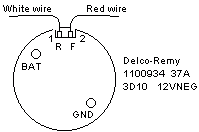Note:Your
alternator must be a GM alternator with a built in voltage regulator! If
an alternator that has a built in voltage regulator is used (and properly connected),
the output voltage will increase until it reaches about 14 volts. That�s it.
No matter how fast it is rotated, the output will never go above that value.
This is the ideal charging voltage for a lead acid battery (a standard car
battery). If you select this alternator, then there are 4 connections that
must be made.  The
pins an a Delco-Remy 1100934 37A, 3D10 12VNEG alternator with built in voltage
regulator:
BAT:
The
main +12V output. This line connects directly to the "POS" terminal on the
battery. GND:
This
is the negative terminal. Connects to the "NEG" terminal on the battery. F:
This
terminal is the voltage sense line for the alternator. Connect this directly
to either the "POS" terminal on the battery, or the "BAT" terminal on the alternator.
R:
This
terminal is the power for the internal regulator circuit. This line must be
connected through a switch to either the "BAT" terminal on the alternator,
or the "POS" terminal on the battery. This terminal will draw power from the
battery any time the switch is on, so YOU
MUST
switch
it off when the generator is not in use, or your battery will be discharged
over time through this terminal. Another
note: If
you turn off the switch that goes to the "R" terminal. The alternator will
"free wheel" with no load on the turbine. If the switch is on, the alternator
will try to output voltage if there is a wind.
|  Most
windmill designs are geared to turn the pump at around 30-40 r.p.m. You will
have to experiment to get the desired output from your turbine. Since the Wind
Chute rotates 180 degrees you will need flexible hoses such as garden hose
with plenty of slack so as not to restrict turning of the assembly. Some have
suggested using a washing machine pump, but I don't know how reliable that
would be. I would rather use an automotive water pump that could handle a higher
r.p.m. because they are pretty much standardized and easily replaced, not to
mention inexpensive.
Most
windmill designs are geared to turn the pump at around 30-40 r.p.m. You will
have to experiment to get the desired output from your turbine. Since the Wind
Chute rotates 180 degrees you will need flexible hoses such as garden hose
with plenty of slack so as not to restrict turning of the assembly. Some have
suggested using a washing machine pump, but I don't know how reliable that
would be. I would rather use an automotive water pump that could handle a higher
r.p.m. because they are pretty much standardized and easily replaced, not to
mention inexpensive.